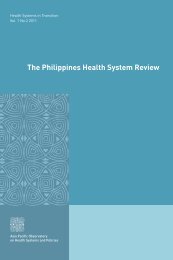Building capacity for NCD prevention and control meeting
Building capacity for NCD prevention and control meeting
Building capacity for NCD prevention and control meeting
Create successful ePaper yourself
Turn your PDF publications into a flip-book with our unique Google optimized e-Paper software.
20<br />
REPORT: REGIONAL MEETING ON PREVENTION AND CONTROL OF <strong>NCD</strong><br />
Part 1<br />
<strong>Building</strong> Capacity <strong>for</strong> <strong>NCD</strong> Prevention <strong>and</strong> Control<br />
<strong>prevention</strong> <strong>and</strong> <strong>control</strong>. He challenged participants to be creative in their recommendations at the end of<br />
the <strong>meeting</strong> <strong>and</strong> encouraged them to draw on examples of good practice, such as healthy settings <strong>and</strong> the<br />
<strong>capacity</strong>-building process used <strong>for</strong> the JWIVP.<br />
Participants were then treated to a presentation by the keynote speaker, Sir George Alleyne, United Nations<br />
Secretary-General’s Special Envoy on HIV/AIDS in the Caribbean <strong>and</strong> Director Emeritus of the WHO Regional<br />
Offi ce <strong>for</strong> the Americas. He spoke of the challenges of <strong>NCD</strong> <strong>prevention</strong> <strong>and</strong> <strong>control</strong> <strong>and</strong> then on overcoming<br />
those challenges. While most would be familiar with fi gures on <strong>NCD</strong> prevalence, Sir George went over the<br />
data to remind participants how many people are suff ering <strong>and</strong> dying <strong>and</strong> to ask why the world seems<br />
so inattentive? He argued that due recognition would come with a mention of <strong>NCD</strong>s in the Millennium<br />
Development Goals (#6) <strong>and</strong> outlined a plan <strong>for</strong> getting it on the agenda of high-level <strong>meeting</strong>s, such as the<br />
Commonwealth Heads of Government Meeting (CHOGM). To overcome the challenges of <strong>NCD</strong>, there is a<br />
need <strong>for</strong> committed <strong>and</strong> eff ective leaders—leaders with vision, values <strong>and</strong> vigour.<br />
Appointment of Chairperson <strong>and</strong> Co-Chairperson<br />
Ms Justina Langidrik from the Marshall Isl<strong>and</strong>s was elected Chairperson <strong>and</strong> Dr Khurelbaatar Nyamdavaa,<br />
State Secretary, Ministry of Health, Mongolia, was elected Co-Chairperson.<br />
Global <strong>and</strong> regional action plans <strong>and</strong> their implementation<br />
Dr Fiona Adshead, Director, Department of Chronic Disease <strong>and</strong> Health Promotion, WHO Headquarters,<br />
reviewed the content of the Global Strategy <strong>for</strong> the Prevention <strong>and</strong> Control of Noncommunicable <strong>and</strong><br />
provided strategic guidance on implementation, noting that the World Economic Forum is now predicting<br />
<strong>NCD</strong>s will have a high negative impact on economic production <strong>and</strong> suggesting this type of in<strong>for</strong>mation<br />
should be used <strong>for</strong> advocacy. She highlighted the need to act on <strong>prevention</strong> <strong>and</strong> the need to do this from<br />
a settings approach, the importance of linking chronic diseases to development <strong>and</strong> social determinants<br />
of health, to assessing risk <strong>and</strong> acting in primary care (linking communicable <strong>and</strong> noncommunicable<br />
programmes). Action on salt <strong>and</strong> tobacco is very cost-eff ective <strong>and</strong> she mentioned regional plans <strong>for</strong> an<br />
emerging network on salt in South-East Asia.<br />
Dr Annette David then spoke to how the regional plan integrated with the global plan <strong>and</strong> reviewed the fi rst<br />
three days of the <strong>meeting</strong> to describe how participants had arrived at policy, population-based interventions<br />
<strong>and</strong> monitoring <strong>and</strong> evaluation as the areas identifi ed <strong>for</strong> fi rst steps in scaling up <strong>NCD</strong> <strong>prevention</strong> <strong>and</strong><br />
<strong>control</strong>.<br />
Representatives of the groups that had discussed these issues in the previous three days then gave<br />
presentations to the senior policy-makers on why they thought the areas of policy, population interventions<br />
<strong>and</strong> monitoring <strong>and</strong> evaluation should be acted on fi rst <strong>and</strong> outlined practical actions that could be taken.<br />
Feedback from senior policy-makers <strong>and</strong> technical advisors<br />
Feedback was very appreciative of the work that had occurred over the previous three days <strong>and</strong> the <strong>capacity</strong>building<br />
that had occurred through the JWIVP over fi ve years. Discussion revolved around the importance<br />
of creating an environment that is conducive to healthy behaviours <strong>and</strong> this was summarized by the<br />
Chairperson, who said that healthy choices need to be easy choices.

















